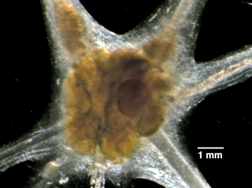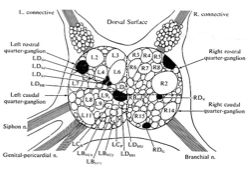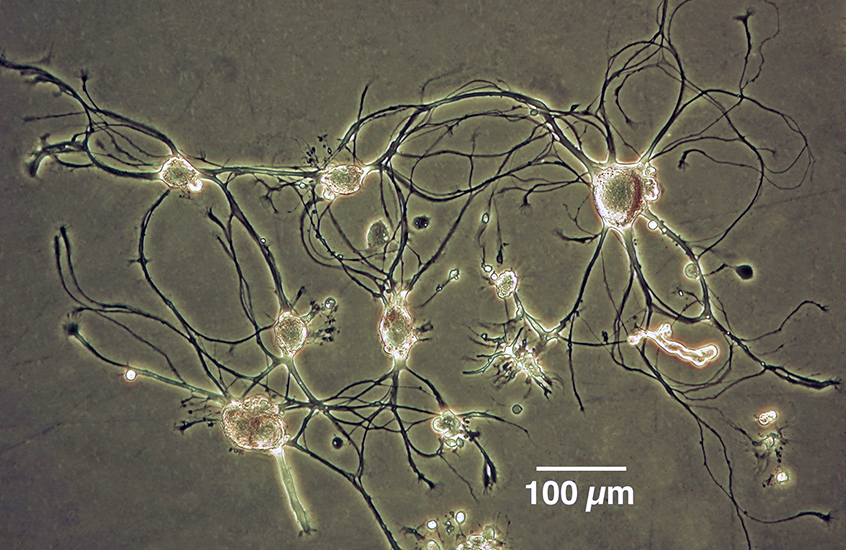For over 50 years the California sea hare, Aplysia californica, has been an important model for study of the function of the nervous system (neurophysiology) and investigation of the cellular and molecular basis of behavior. This research was popularized by Eric Kandel at Columbia University in New York but the use of this model has spread to labs around the world. In 2000, Professor Kandel was awarded a Nobel Prize for his pioneering studies using Aplysia.
Why is Aplysia such a good model system?
- The Aplysia nervous system is relatively simple (105 to 106 neurons as compared to ~1012 neurons in the human brain).
- Many of the nerve cell bodies of the Aplysia are relatively large (up to 1 mm for the largest neurons in the abdominal ganglion) facilitating many types of experiments.
- The large neurons are found in the same locations in the brains of all individuals, enabling scientists to find them easily during experiments that involve behavior, learning, and electrophysiology or molecular biology of the individual neurons.
- Aplysia is capable of a number of behaviors and of simple forms of learning.
 |
 |
The Nervous System of Aplysia californica
Image and Map of identified cells in the abdominal ganglion of A. californica indicating locations of many commonly studied neurons. The identified cells are labeled L or R for Left or Right hemiganglion and assigned a number. Figure on right adapted from Kandel (1979) Behavioral Biology of Aplysia, a Contribution to the Comparative Study of Opisthobranch Molluscs. San Francisco: W. H. Freeman and Company. 463 pp. |
 |
 |
Image and Map of identified cells in the abdominal ganglion of A. californica indicating locations of many commonly studied neurons. The identified cells are labeled L or R for Left or Right hemiganglion and assigned a number. Figure on right adapted from Kandel (1979) Behavioral Biology of Aplysia, a Contribution to the Comparative Study of Opisthobranch Molluscs. San Francisco: W. H. Freeman and Company. 463 pp.
|
Kandel and his co-workers (Kandel, 1979) were the first to show that simple behaviors such as habituation can be produced by defined changes in neurons over time. Habituation, perhaps the simplest form of nonassociative learning, is a progressive decrease in the strength of a behavioral response to a relatively weak natural stimulus of constant intensity when that stimulus is repeatedly presented. Habituation is not the result of sensory adaptation or motor fatigue, but represents a learned change in the animal's responsiveness to the stimulus. Sensitization, the mirror image process of habituation, is a slightly more complex form of learning; it is the enhancement of a reflex response to one stimulus as a result of the presentation of another, noxious, stimulus. Distinct forms of these learned responses, such as short and long term, are recognized in Aplysia (and many other animals).
The best characterized pathways for habituation and sensitization in Aplysia are those involving the siphon and gill withdrawal reflexes. Briefly, these reflexes involve sensory nerves, motor nerves and interneurons, all of which have cell bodies located in the abdominal ganglion. During habituation, the synaptic connections between the sensory nerves that sense stimulation of the tail and the motor neurons that contract the tail undergo a depression in activity due to a decrease in neurotransmitter release by the sensory neurons. In contrast, a sensitizing stimulus produces rapid facilitation (enhancement) of the same connections due to an increase in the amount of transmitter released per impulse. A simplified version of this pathway, involving just two cells, can be reconstituted in cell culture, permitting detailed analysis of the molecular changes involved in these forms of learning.

Aplysia neurons in cell culture can be used to study ion channel function, synapse formation and cellular and molecular changes associated with learning and memory.
Genome and Transcriptome of Aplysia
The representative genome of A. californica was sequenced and assembled by the Broad Institute. DNA for whole genome sequencing was isolated from a 4th generation inbred animal (F4) reared at the National Resource for Aplysia. The primary assembly was generated from deep coverage Illumina reads using ALLPATHS-LG. The assembly was subsequently extended and gaps filled using a previous assembly generated from Sanger sequencing reads with ARACHNE. The most recent representative genome assembly available is AplCal3.0, released in 2013: https://www.ncbi.nlm.nih.gov/assembly/GCF_000002075.1/
This assembly reveals that the genome size of A. californica is approximately 927 Mbp.
The reference genome was annotated by the automated NCBI Eukaryotic Genome Annotation Pipeline, with inclusion of RNA sequencing data from several tissues. The most recent RefSeq Annotation Release is 102, released on Aug 31 2020:
https://www.ncbi.nlm.nih.gov/genome/annotation_euk/Aplysia_californica/102/








